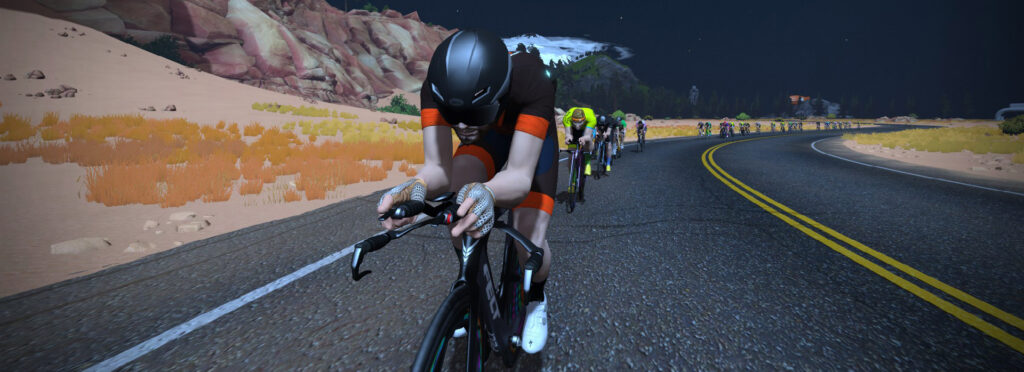Ah, time trialing. The race of truth. You against the clock. While they aren’t as popular as scratch races on Zwift, the individual time trial (iTT) format is something every rider should experience at least once. It’s a challenge of pacing, mental fortitude, of course, physical strength.
See upcoming TT races on ZwiftHacks >
We hope you find these tips useful. Got tips of your own, or TT questions? Share in the comments!

#1: Know Yourself
Self-knowledge is such an important part of racing, and the only way to get it is through experience.
The more you ride, the more you’ll learn what threshold work really feels like – and this is so important for time trials. Yes, you can use the numbers on screen and try to hold a particular wattage – but what if you are a little fatigued going into your ride? Or what if you’re actually stronger than your last FTP test indicated? This is where being able to “feel” your threshold is so important, as it lets you push to the max of what you can handle right now.
It’s also important to know how quickly you recover from over-threshold efforts. Are you the type of rider who really needs to hold a steady effort, or can you throw in regular over-threshold efforts then recover? This will determine how you attack different portions of a course, especially when it’s a hilly time trial.
#2: Know the Route
Experienced racers always recon a TT the course, because (as we’ll see below) this lets you plan your effort.
Outside rides present many variables as well: wind, weather, road surface, etc. Time trialing on Zwift simplifies things somewhat by removing many of these variables. Plus, all the Zwift route details you need are available within a few clicks. Check out our Complete Master List of All Zwift Course Routes for detailed maps and descriptions of any Zwift route.
#3: Don’t Skip the Warmup
When your race begins you’ll go from zero to threshold quickly, and this will be a shock to your system if you aren’t sufficiently warmed up beforehand. Take the time to perform a complete warmup, beginning with easy spinning then ramping up to threshold heart rate levels.
How much warmup do you need? This varies from rider to rider, but generally the shorter the race, the longer the warmup. A 20km TT may require a 30-minute warmup, while a 40km TT may require 15-20 minutes. (Shorter races are ridden at higher power levels, thus requiring more substantial warmups.)
You should be at the start line sweating and thoroughly warmed up. Ready? Let’s go!
#4: Start Slow
Don’t come out of the gate with guns blazing. Get up to speed in the first 30 seconds, but don’t fatigue yourself early. Riders commonly overcook themselves in the first few minutes of a time trial due to adrenaline, excitement, and fresh legs. Don’t fall into the trap!
Pop quiz: which is better?
- Riding at 100% of FTP for 10 minutes before blowing up and having to finish with 30 minutes at 80% of FTP
- Riding at 90% of FTP for the first 35 minutes, then 100% for the final 5 minutes
It’s an over-simplified example, but you get the idea. #2 will get you further, faster.
#5: Over-Pace Uphill, Recover Downhill
If your route is anything but pan-flat you will want to plan your power on the hills. To keep it simple, try to hold 5-10% over your “race pace” power when climbing, then let yourself drop a bit below race pace once you’re up to speed on the descents. This uses your power most efficiently, which in turn maximizes overall race speed.
It’s easy to cook yourself when the climb starts and the resistance increases, but don’t do it! Rather, start slightly over pace, then increase the level of over-pacing so you can finish strong and accelerate over the top. This is known as “progressive over-pacing.”
Bonus Tip: Upgrade Your TT Rig!
Time trialists are famous for obsessing over their bikes, constantly tweaking settings and upgrading parts to get the most aerodynamic yet ridable setup.
It’s easy (and more affordable) on Zwift, and upgrading from a basic TT setup can save you 90 seconds or more over an hour-long race. So pick the fastest bike you can afford! Read Fastest TT Bike Frames and Wheels at Each Zwift Level for guidance on picking the fastest frame and wheels.
Your Tips?
Any TT tips to share? Comment below!

